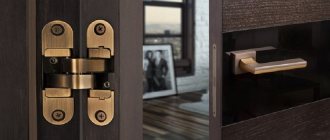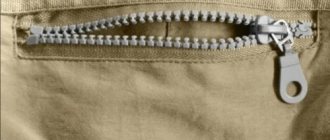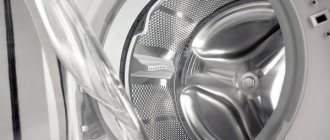Opening an interior door lock without using a key is not difficult. Firstly, for internal doors to a room, the simplest models of locking mechanisms are usually used; they are also the cheapest and, as a result, fragile.
Therefore, you can open them in a variety of different, sometimes very non-trivial ways.
Reasons for the situation
To understand what and how to open an interior door that is blocked, it is necessary to identify the reason that provoked the occurrence of such a situation. The door leaf may not open in the usual way in the following cases:
- the locking latch has moved or is jammed;
- igniter tongue located in the locking mechanism (not retracted from the strike plate);
- there is a key left in the keyhole on the other side of the locking device, which prevents you from opening the lock;
- breakdown of the button mechanism;
- the key broke off, part of it remained in the keyhole and does not allow opening the device;
- the lock mechanism is broken;
- accidentally (due to a draft, a child's prank, etc.) the interior door slammed shut, while the locking mechanism is working, but the key to it is lost.
Video description
How to open a door without a key.
Removing door hinges
It is not always possible to open a door without a key using various master keys. In such cases, they resort to another common method of solving the blocking problem - removing the door leaf.
The fastening loops consist of two identical parts. If there is a sufficient gap between the door itself and the frame, it is worth trying to remove them from the awnings. In some cases, it is possible to unwind small elements.
It is possible to carry out such a procedure only when there is access to the fittings. The situation becomes more complicated when hidden mechanisms are used in the door structure.
Removing the door leaf from the hinges is only possible if there are sufficient gaps Source dvervdome.ru
Possible methods
Latch offset
One of the effective methods of opening the door to a room. Basically, models installed in openings inside the home have a push or turn handle.
- Without a lock. The most convenient locks to open. It is enough to press the tongue and the door will open. When installing the block, there is always a small gap between the canvas and the box. All you need to do is press the sash a little, insert a flat, hard object into the slot and try to move the latch. As a rule, it gives in easily, and if you pull the door towards you, it will open. What can you use? A nail file, a kitchen knife, a screwdriver with a thin blade, or something similar. For lack of anything better, a bank (plastic) card will also come in handy.
If the child has locked the latch from the inside (for example, the door to the bathroom), but for some reason cannot move it on his own (or simply fell asleep), then this method is also suitable for such a situation. By “playing” with the door a little, you will be able to dislodge the lock and enter the room.
- With a lock. These models, if they were not installed independently, with a security key, can be opened easily. The mechanism is turned by any flat and narrow object - the same thin screwdriver, wire loop, paper clip, hair clip. It is enough to insert the “tool” into the well, and after two or three attempts the valve will open.
Some interior door locks have a button-shaped plug. It is necessary to grab its “head” with pliers and turn it in the desired direction. The latch will definitely move.
Opening the lock
Some owners equip interior doors with lever and cylinder locking mechanisms. How to open such a lock without a key? It's not a fact that it will work, but it's worth a try.
If the interior door slams, then first you should pull it a little. The bolts in the simplest models of locks, as a rule, bounce off and the sash is unlocked.
- Try to open the lock with a key of a similar configuration. If the mechanism is very worn, then most likely it will work.
- Knock out or drill out the cylinder.
- Disassemble the handle and move the valve bar from the inside.
When choosing a technique, you need to focus on the design features of the lock. But at least one of them will definitely help if there is no simpler option.
Dismantling
If you cannot open the interior door lock without a key, you will have to choose this method. The nuance is that it is not always possible to implement it. Canopies differ in design and installation specifics, and if they are hidden, then this is not an option.
Basically, to fasten the doors of interior models, card-type hinges in various designs are used (hinged, “butterfly” and a number of others). What they have in common is that they are fixed to the frame and jamb using self-tapping screws. It is enough to unscrew the fasteners on one side of each hinge, move the door slightly (so that the latch tongue comes out of the bar), and the door will easily be removed from the opening.
Another way is to partially disassemble the canopy. The design of some samples allows this to be done. And if you have time and have preserved the product passport, which contains the necessary information, then the task is significantly simplified.
The dismantling technique allows you to unlock the opening without damaging the sash, frame and locking mechanism.
How to open the interior door will have to be decided on the spot. The only recommendation is to start preferably with “gentle” methods, gradually moving on to more complex ones. This ensures that defects on the block, if they appear, will be minimal.
Opening options
The method that should be used to solve this situation directly depends on the locking hardware used in the door structure. You can try to open different locks in different ways. Some complex mechanisms should not be tackled; it is better to immediately call a specialist, and he will open the interior doors using a special tool. But most often, simple door components are installed on the interior panels.
Remove from hinges
A fairly common and easiest way to open an interior door system is to remove the door leaf from the hinges. This option is only possible if you are inside the room, when this fittings are in the access zone. If there is sufficient distance between the leaf and the frame, the door can be easily removed.
For internal systems, simple card loops are most often used, which are sometimes equipped with removable decorative plugs. By unscrewing this element, you can pull out the pin, and the door is simply removed from the opening.
Key lock
When the locking mechanism is additionally equipped with a cylinder for locking with a key, then in this version you can open the interior door lock in the following ways:
- Sometimes you can get rid of a slammed door by pulling the door handle hard several times. In a simple and loose mechanism, the bolt can bounce off on its own with a little physical force.
- You can try to open the lock with a similar key. Some locking mechanisms operate from several similar keys, and not just from those included in the kit.
- Sometimes the lock is turned by a paper clip, a knitting needle, a nail file, or various other thin objects. An improvised master key is inserted into the cylinder and turned, trying to move the levers or pins away. The process requires some skill and accuracy.
- If all else fails, then you can use one of the relatively harmless options and try to remove the lock. Using a screwdriver (file, ruler, knife, etc.), unscrew all visible screws, then remove the handles and decorative trims. Having gained access to the locking mechanism, you need to try to turn it. The cylinder may have to be drilled out.
Using brute force
If none of the above methods succeeded in opening the lock, then brute force is applied to the slammed door. Breaking into an interior door is carried out using the following force methods:
- You can cut off the hinges along the plate or hinge axis so as not to damage the blade itself and the locking mechanism. This is not possible with hidden fittings.
- If the lock latch is clearly visible in the gap between the door leaf itself and the frame, then it is cut off using a hacksaw. You can use a grinder, but you will have to take measures to protect the door from sparks.
- In the most extreme case, the door leaf is knocked out of the frame. This is acceptable for structures that do not have high strength or in the absence of the necessary devices, as well as if it is necessary to urgently open the door to prevent other more severe consequences.
- The blade can be pressed away from the jamb using a chisel, large screwdriver or pry bar. The tool is inserted into the gap between the door frame and the door in the area where the latch tab is located, then you need to try to force it back to the desired open position or remove it from the hole in the strike plate.
- Drilling a hole in the locking mechanism cylinder will keep the entire door unit intact, but will require replacing the lock. The narthex mechanism is grasped with a thin tool through the hole made, and the crossbars are returned back to the locking device.
After using these methods, you will most likely have to change the fittings, restore the door jamb or door leaf. Sometimes it may be necessary to completely replace the entire door along with the frame, so brute force is used as a last resort.
Latch on interior door
Situations quite often occur when the spring in the latch breaks, and the locking tongue does not move when you press the door handle. You can open a closed door by moving the latch. You will need a thin screwdriver, scissors, a knife, a metal ruler, a plastic card, a file or any other thin and durable device. You need to place the tool in the gap between the door jamb and the leaf at the location of the locking mechanism and, carefully pressing the tool on the tongue, push it towards the lock and remove it from the strike plate.
This method can be used if the side of the locking device where the tongue has a bevel is accessible, otherwise it is difficult to fix the tool, because it will slip. A straight latch that does not have a cut can be moved by placing the tool on top. In this case, you need to try to hold the tool at an angle in order to reach the beveled inner side of the tongue. Then press and push the latch while turning the door handle.
Other lock mechanisms
Quite often, key locking devices are used for doors between rooms, which are locked by simply pressing a button. Such a lock can close on its own if the door is slammed hard. A good quality product is equipped with insurance to help cope with such an unpleasant situation. For this purpose, a special hole is provided at the bottom of the outer part of the handle. If you insert a thin device (an awl, a nail, a knitting needle, etc.) into it and then press lightly, the safety mechanism is triggered and the door lock opens.
Some locking structures are additionally equipped with locking handles that prevent the door from opening from the outside. Such mechanisms are often used in toilets and bathrooms. If the lock is jammed, sometimes it is possible to open the door by turning the handle several times in different directions.
If these manipulations are unsuccessful, you will have to open the locking device. To gain access to the locked mechanism, you need to remove the decorative trim. It is removed by first unscrewing the screws using a screwdriver, ruler, knife, nail file or any similar object, then the lock is unlocked by pressing the locking device and simultaneously turning the handle.
How to open a slammed interior door: recommendations
Everyone knows the stories of jumping out onto the staircase and the front door slamming shut, but such a situation can also arise with an interior door. This is possible when there are small children in the house; sometimes animals can become the culprits of the situation. It also happens that the lock is simply jammed, that is, the reasons may be different, but they have one thing in common - the question of how to open an interior door?
Most often, the lock system fails due to negligence, and therefore, in order to avoid this, it is necessary to contact specialists at the slightest sign of poor lock operation.
Required Tools
In order to open interior doors without a key, you may need the following tool:
- flat and Phillips screwdrivers;
- hammer;
- pry bar, chisel;
- pliers;
- angle grinder (grinder);
- hacksaw for metal.
If it is not possible to use such tools, then you can use any available means. A straightened paper clip, knitting needle, nail file, or other long metal object will work to open the small round keyhole.
Door opening methods
It doesn’t matter why the door is closed, but it needs to be opened. The easiest way is to call a specialist to your home, but this is not always possible. For example, the service is very expensive or the technician is busy for the next few days, and so on. The door must be opened so as not to damage it. Well, or at least cause a minimum of visible damage to it, especially if it is new or the purchase is not included in your plans for the next couple of years.
The easiest way to open a slammed door is to seek help from a locksmith service.
You should not immediately start to fight in hysterics, especially if a child has locked himself in the room - he will hear your excitement, and by doing this you will make it worse for both yourself and him. Take a deep breath, calm down, and get to work. You can try to open the interior door in several ways:
- Using a plastic card.
- Using knitting needles.
- Using a nail, hairpin, wire.
- Using a screwdriver and other similar items you find.
The choice of a specific method will depend on the installed opening mechanism, on your skill and luck.
Related article: How to set up a door closer
Often, just having a plastic card is enough to solve the problem. This method is more suitable for those models that are equipped with a regular “tongue”. In this case, everything is quite: take the card and swipe it along the door lock, then click on the handle.
Latch
The simplest mechanism, consisting of only two elements - the body and the tongue. Serves to prevent the door from spontaneously swinging open. It has a budget price. In addition to its affordable price, the device attracts:
- long service life;
- ease of recovery;
- reliability of the design;
- no need for a key;
- very rare breakdowns.
In this case, different types of latches can be used - latches, roller, magnetic, sliding or with a lock. The first type of locking mechanism is equipped with a tongue that is beveled on one or both sides. In the second case, the tongue is presented in the form of a rotating roller.
Magnetic ones hold the door using the system of the same name. And for sliding ones, the latch acts as a bolt. To open or close it, you need to pull the lever or rotate it around its axis. Locking mechanisms with a latch are similar to locks. The latch blocks the rotating or pressing mechanism.
Important ! If latches of this type are handled incorrectly, the latch may fail and the tongue may jam.
Measures to prevent such a situation
Difficulties with difficulty opening an interior door are easier to prevent than to attempt to eliminate the breakdown over a long period of time. What to do if you don’t want to learn the art of hacking at home? You must follow these simple rules:
- Carry out regular maintenance of locking mechanisms.
- Purchase locks with emergency opening capabilities.
- When installing, leave a gap between the door leaf and the jamb.
- Keep a spare set of keys within reach.
- Replace faulty locks in a timely manner.
By following simple recommendations, you can avoid unpleasant moments with locked rooms, jammed locks and unplanned expenses for purchasing new doors. It would also be useful to protect your nerve cells and protect yourself from shocks. After all, 90% of inner peace and peace in one’s home depends on the success of the owner’s actions.
Through the lock cylinder
There are several options for penetration using the lock cylinder. Depends on the degree of intervention in the mechanism and the ability to protect property from significant damage:
- Gentle . Here it is enough to use a paper clip, hairpin or wire.
- Moderate weight . Now is the time to use a master key or similar device.
- Destructive . Here they use a screwdriver, drill, hammer and remove the larva completely, opening access to the locked room.
Caution is the first thing that is necessary when choosing one method or another. After some damage, it will no longer be possible to repair the door.
Lock with handle
According to their design features, door handles are divided into the following types:
- Push . They are distinguished by the greatest reliability and comfort. Unlocking is activated by pressing the handle down. After it returns to its original position, the lock is locked again.
- Knob handles . Here the ball-shaped handle turns to the right or left. Allows you to lock the door mechanism from the inside.
- Invoices . Pull handles are the simplest metal accessories for manipulating the door leaf. If executed successfully, they can advantageously complement the interior decoration of a room.
- For compartment type doors . If the trajectory of movement runs parallel to the wall, install overhead handles. Wooden models with a cassette built into the wall are equipped with devices without a protruding handle.
Handles for interior doors can have a base plate in the form of a rosette or a plate. A rosette is a part in the shape of a circle or square. Always compact and has regular outlines. Plate - an elongated element at least 10 cm long with straight or rounded corners. A much more reliable option for attaching a door handle than the previous one.
Reference ! Door handles are made from wood, glass and plastic. However, metal ones are the most popular. The color is selected depending on the shade of the canvas.











